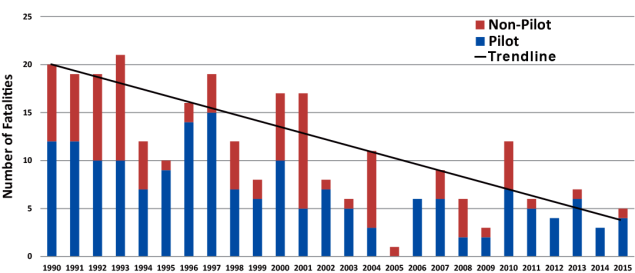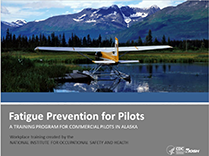Aviation Safety Research Project
Research and collaboration with industry partners to prevent work-related fatalities, injuries, and illnesses among Alaskan aviation workers.
Alaska is uniquely dependent upon air transportation. Commuter and air taxi operators serve as the main link to much of Alaska, transporting people, cargo, and mail to more than 250 villages located off of the road system, that’s over 80% of the towns and villages in Alaska. This critical mode of transportation can be hazardous. View a video about the Alaska Aviation Lifeline. The content of the video is also available on YouTube.
A disproportionate number of commuter and air taxi accidents occur in Alaska. During 1990-2015 there were 1,874 commuter and air taxi accidents in the United States. Commuter and air taxi accidents in Alaska accounted for more than one-third of those events and more than 20% of the fatal events and deaths in the U.S.
| U.S. Accidents | Alaska Accidents | |
|---|---|---|
| Number of events | 1874 | 674 (36%*) |
| Number of fatal events | 454 | 96 (21%*) |
| Number of fatalities | 1296 | 279 (22%*) |
* Percent of all U.S. commuter and air taxi crashes.

Aviation is a hazardous mode of transportation for pilots and passengers alike. During 2000-2015, non-military aviation events in Alaska caused fatal injuries to 46 workers who were in or around aircraft as part of their jobs. During this same time period, 76 occupational pilot deaths occurred (excluding military), an average of 5 pilot fatalities per year, compared to an average of 10 pilot fatalities per year during 1990-1999. These 76 fatalities over 16 years from a commercial pilot workforce of approximately 2,600 results in an annual pilot fatality rate of 183 per 100,000 pilots. While this is an improvement from the 1990s, it is still almost 50 times the fatality rate for all U.S. workers and more than twice the occupational fatality rate for all U.S. pilots. For more information on safety improvements in Alaska, please see our fact sheet or read the article.
NIOSH continues to work to reduce Controlled Flight into Terrain accidents , prevent mid-air collisions and provide fatigue awareness and education for pilots to improve aviation safety for workers in Alaska.
- Reducing Controlled Flight Into Terrain (CFIT) Accidents
- Preventing Mid-Air Collisions
- Preventing Non-fatal Aviation-related Injuries & Illnesses in Alaska
- Fatigue Prevention for Pilots
- Aviation Safety in Wildland Firefighting
- Current Partners & Links to Aviation Safety Resources
- NIOSH Aviation Safety Publications

